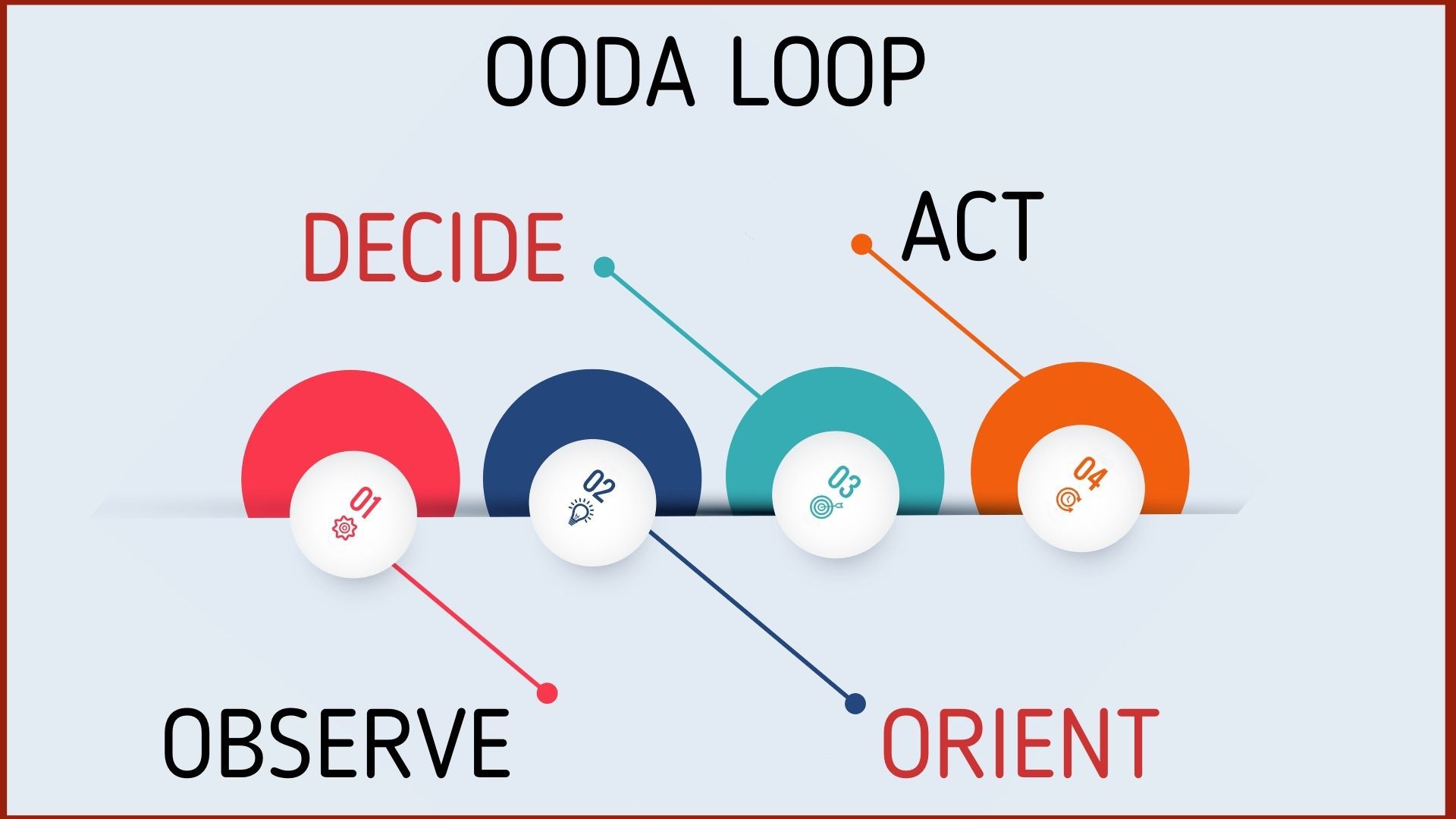Definition: OODA Loop is the concept designed initially for the combat operations proceedings, and now it is also applied for understanding learning processes, commercial operations, cyber-security, and cyber warfare.
Developed by military strategist and the United States Air Force Colonel John Boyd, OODA revolves around a recurring cycle of
- observe
- orient
- decide
- act
for effective decision-making.
This OODA cycle is used in thinking critically, anticipating threats, and neutralizing them way before they become precarious. It tells how effective agility is in overcoming raw-power in dealing with different sorts of opponents.
This post will take you deep into the OODA loop and help you understand how it can help in making better, effective, and productive decisions. So, without delaying any further ado, let us get started here and now-
Table of Contents
Introduction
To be successful in a business or to be victorious on a battlefield, what one requires is proper foresight, meticulous planning, and perfect execution.
But what if one doesn’t have the very element necessary to do these things, time?
Being a fighter pilot is one of the most robust and highly skilled jobs on this planet.
The fast-paced world of air-to-air combat needs a quick assessment of the situation and lightning-fast decision making. One wrong decision or a slight delay in execution can cost you your life.
In such a case, the pilots need to have a full-proof strategy for making the correct decisions and acting accordingly.
To serve this purpose, the United States Air Force Colonel John Boyd devised a four-step policy and named it the OODA Loop.
Today, this policy is beneficial in a varied array of fields like military strategy, litigation, business, and law enforcement. Let us know more about the OODA loop.
What is the OODA Loop?
Military training and actions need perfect decisions and quick responses.
The OODA loop is a system devised by the US military, which helps individuals in decision-making. It consists of four steps.
- Observe
- Orient
- Decide
- Act
During any process that involves decision making and execution, these processes continuously run in a loop by continuously feeding into each other.
This loop enables the decision-makers to engage in reasoning, foresee the problems, analyze them, and counterbalance them before they take up a complicated form.
Why was the OODA loop made?
Colonel Boyd, the one who devised the OODA loop, is known as the ‘Fighter pilot who changed the art of war.’ During the later part of the Korean War, he was an F-86 pilot and commanded over a fighter pilot group.
He believed that even if a pilot is in a compromised position, he still can overcome it and end up victorious in the combat by ‘attacking the opponent’s mind.’ He observed the necessary human behavior and reaction time in such times of crisis.
Based on his observations, he devised the OODA loop strategy. He trained his pilots according to this strategy. It was observed that the ones who were trained with this strategy had a 10 to 1 kill ratio while taking over the superior Mig-15 fighter jets.
The loop gained immense popularity and widespread utility value in a vast range of fields from there onwards.
Steps in the OODA loop
1. Observe
It is the first and foremost step. In this, the decision-maker needs to collect every piece of data and information that is available. The report doesn’t need to be prioritized right now. All they need to do is to gather as much data as possible from every accessible source.
Let’s use the real example on which the loop was initially based on- a fighter pilot. What does a fighter pilot have to observe during combat? He must watch not only his opponent’s actions, but also the gauges in his cockpit, his place in the sky, and the sight of his relationship with the ground.
2. Orient
In this step, the data collected is analyzed and broken down to convert it into knowledge. The overall situation and the threats, opportunities, and competitors associated with it are taken into consideration to visualize a clear picture.
According to Boyd, this is the most critical phase of the loop. If mastered by someone, this phase can successfully predict outcomes with high probabilities of them working right. This phase provides a state of awareness.
3. Decide
When analyzing the situation, one will come across many possible courses of action that one might take. Every effort will have a different outcome. In this phase, one decides the work that will deliver the optimal result as per the requirement.
If the above two steps are science, the last two steps are the art of the process. No two individuals think equally. If you give ten people the situation, all of them might come with a different outcome. But if you provide them with a target optimal outcome and employ the loop, they will come up with the best course of action.
4. Act
Two things are done in this step-
- Execution of the decision
- Determining the correctness of the prior hypothesis made
As this is a loop, this is never the last step. The cycle will begin again after this step.
The validity of the action will be observed in the outcome, and if it is not the one required, it can be efficiently changed in the next cycle. Subsequently, subsequent cycles can be more efficient and quick.
This step is also the most challenging step for the majority of people. As they get the luxury of data collection and analysis, they get caught up in over-analysis and fail to execute the action at the right time. All of the above steps go in vain if the action is not completed timely. Hence the timing of this step is of the essence.
One will never get a hundred percent information. The ability to act timely by analyzing the available information is what separates the one who succeeds from the one who failed.
The Loop formation of OODA Concept
After all, the above steps are not just steps that come one after the other.
If you observe, you will see that the steps cyclically affect each other while continuously feeding one another.
Let’s take the example of the fighter pilots again. There, a pilot cannot just take action, wait for the outcome, and start all over again. There, no two loops will be similar. Every action the pilot takes, his opponent will act accordingly.
He observes, orients, decides, acts, again sees the outcomes, and follows the procedure endlessly for hundreds of times.
The one who will be more aware of the loop will be the inexperienced one.
As his experience will increase, he will be running the steps simultaneously. All of them would be existing together, feeding into one another.
Importance of the OODA loop
The military widely uses the OODA loop, law enforcement authorities, and the corporate world to enhance decision-making capacity.
In today’s world, with the growing use of digital technology, data has become a currency. The one with the most data is the ruler of the market.
However, to analyze this data and convert it into a strategy and eventually into beneficial action, all of that needs to be processed. The OODA loop serves to scrutinize this humongous amount of data and turn it into useful insights.
Furthermore, the value of the derived results can be increased manifold by setting prior goals.
Measuring the success of the OODA Loop
In the business world, the companies whose loop is successful will have a quick and short OODA loop.
They will be able to ingest information quickly, work on it, and understand the possible actions, find the one which will give the desired result, and execute the action.
The companies with unsuccessful strategies will have a long, slow loop.
They wouldn’t be able to make full use of the sources to ingest information, analyze it, and decide and execute the correct actions.
Personal implications of the OODA Loop
The personal implications of the loop can be understood by understanding the concept of ‘reaction time’ in humans. Reaction time can be defined as the time between the onset of a stimulus and the onset of the reaction to that stimulus.
The processes that happen in between these actions may be called the OODA loop.
The success of the OODA loop in humans
While determining the success of the loop in humans, we can use the same logic used for the industry. A successful OODA loop has to be quick and short.
While interpreting this in humans, we can say that less the reaction time, more successful, is the loop!
However, we being humans, our loops don’t work exactly as the industry. Some additional factors contribute to your reaction time and, subsequently, your OODA loop. Some of them might be
- Known stimulus
- Unknown stimulus
- Denial
- Emotional aspect
- Number of tasks
- Complexity of tasks
Application of OODA Loop in hand to hand combat
This technique was initially developed by military personnel for the military; it has applications in hand to hand combat. Such combats require swift actions and lightning-fast decision-making capabilities, making it the ideal platform for using the OODA loop.
1. Tempo, speed, and timing
The speed and stealth with which the combatant hits the opponent decide a lot about the match result. A combatant can increase all of these by making the use of the loop effectively.
2. Hitting the opponent on the half-beat
During combat, the combatants hit each other in rhythmic punches. The blows they throw at each other are never random. This pattern of punches is known as a beat.
If one uses the loop effectively, one can predict the time and place of the next blow and prevent it successfully. If one chooses to calculate to hit the opponent at half-beat, he can easily confuse the opponent and win the combat. OODA loop can be effectively used for the purpose.
Final Thoughts about the OODA Loop!
From the above points, it is quite clear that the loop can be used in a vast array of fields, on organizational and individual levels.
While some tend to the first part of the loop (analysis) and some to the latter (execution), it is advisable to have a unified approach to get the best possible results.
How practical do you find the OODA loop in effective decision making?
Liked this post? Check out the complete series on Decision Making


